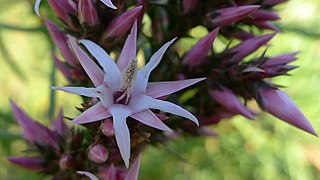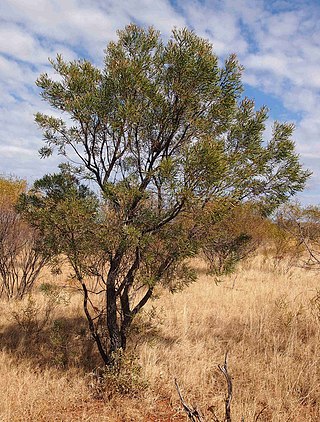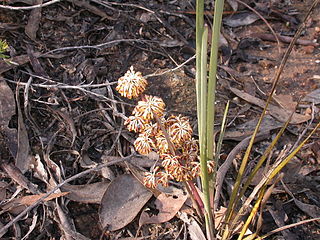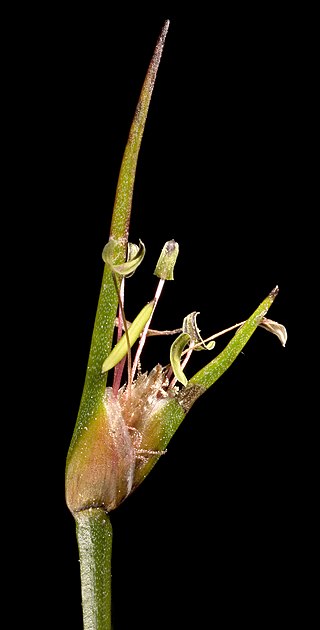
Hakea is a genus of about 150 species of flowering plants in the family Proteaceae, endemic to Australia. They are shrubs or small trees with leaves that are sometimes flat, otherwise circular in cross section in which case they are sometimes divided. The flowers are usually arranged in groups in leaf axils and resemble those of other genera, especially Grevillea. Hakeas have woody fruit which distinguishes them from grevilleas which have non-woody fruit which release the seeds as they mature. Hakeas are found in every state of Australia with the highest species diversity being found in the south west of Western Australia.

Hakea corymbosa, commonly known as the cauliflower hakea, is a species of flowering plant in the family Proteaceae which is endemic to the south-west of Western Australia. An attractive extremely prickly bush with sweetly scented yellowish flowers. The nectar-rich blooms and dense form provides a good habitat for wildlife.

Hakea nodosa, commonly known as yellow hakea, is a shrub that is endemic to Australia. It usually has golden yellow flowers in profusion and needle-shaped leaves.

Hakea ulicina, commonly known as furze hakea, is a shrub in the family Proteaceae and endemic to Victoria. It has stiff, long, narrow leaves and creamy-white flowers.

Hakea decurrens, commonly known as bushy needlewood, is a species of shrub or small tree in the family Proteaceae.

Dillwynia cinerascens, commonly known as grey parrot-pea, is a species of flowering plant in the family Fabaceae and is endemic to south-eastern Australia. It is an erect to low-lying shrub with linear or thread-like leaves and orange or yellow flowers.

Hakea rugosa, commonly known as wrinkled hakea or dwarf hakea, is a shrub of the family Proteaceae native to Australia. It has sharp needle-shaped leaves and white or cream fragrant flowers in profusion from August to October.

Hakea cycloptera, commonly known as elm-seed hakea, is a shrub in the family Proteaceae endemic to South Australia. It is a small spreading shrub with an abundance of pale pink or white flowers from December to August.

Lepidosperma laterale, commonly known as the variable swordsedge, is a plant found in south-eastern Australia, New Caledonia, and New Zealand. It is often found on sandy soils or rocky areas in wooded areas.

Hakea tephrosperma commonly known as hooked needlewood, is a shrub or small tree species in the family Proteaceae. It has cream flowers, needle-shaped leaves and is one of the taller species adaptable for dry to temperate locations.

Sprengelia incarnata, commonly referred to as pink swamp-heath, is a species of flowering plant of the family Ericaceae, and is native to south-eastern Australia and New Zealand. It is an erect, glabrous shrub with sharply-pointed, stem-clasping, egg-shaped leaves, and clusters of pink, tube-shaped flowers with spreading lobes.

Hakea microcarpa , commonly known as small-fruit hakea is a flowering plant in the family Proteaceae and is endemic to eastern Australia. It is a spreading shrub, often growing in woodlands, heathlands and near swamps in montane areas of eastern Australia.

Hakea leucoptera, commonly known as silver needlewood, needle hakea, pin bush or water tree and as booldoobah in the Koori language, is a shrub or small tree with rigid, cylindrical, sharply pointed leaves and white, cream-coloured or yellow flowers in late spring and early summer. It is widespread and common in central parts of the Australian mainland.

Acacia hakeoides, known colloquially as hakea wattle, hakea-leaved wattle or western black wattle, is a species of flowering plant endemic to southern Australia. It is a bushy shrub or tree with lance-shaped to linear phyllodes, racemes of bright golden-yellow flowers and more or less leathery to leathery to hard and brittle pods. It can be found growing in sandy soils in semiarid and Eucalyptus woodland in the region.

Hakea arborescens, commonly known as the common hakea or the yellow hakea, is a shrub or tree of the genus Hakea native to parts of northern Australia.

Hakea actites, commonly known as the mulloway needle bush or wallum hakea is a shrub or tree of the Proteaceae family native to areas in north eastern New South Wales and south eastern Queensland. White nectar-rich flowers appear in abundance from late autumn to early spring.

Hakea divaricata, commonly known as needlewood, corkbark tree or fork-leaved corkwood, is a tree or shrub in the family Proteaceae native to an area in central Australia. A slow growing species with up to 120 showy cream to greenish-yellow flowers in long racemes from June to November.

Lomandra multiflora, also commonly known as many-flowered mat rush, mat rush and many flowered mat-lily, is a perennial, rhizomatous herb found in Australia and Papua New Guinea. The mat rush is distributed widely in the region and common within its preferred growing conditions. Its conservation status is considered not to be of concern and risk.

Centrolepis aristata, commonly known as pointed centrolepis, is a species of plant in the Restionaceae family and is found in areas of southern Australia.

Pimelea curviflora, also known as curved rice-flower, is a shrub in the family Thymelaeaceae and is endemic to Australia. It is a small, hairy shrub with greenish-yellow or red tubular flowers.
























